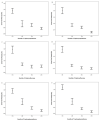Clinical Relevance of Urine Flow Rate and Exposure to Polycyclic Aromatic Hydrocarbons
- PMID: 34070005
- PMCID: PMC8157826
- DOI: 10.3390/ijerph18105372
Clinical Relevance of Urine Flow Rate and Exposure to Polycyclic Aromatic Hydrocarbons
Abstract
Background: Polycyclic aromatic hydrocarbon (PAH) metabolites have received increasing attention because several of these organic substances are highly carcinogenic or mutagenic. Exposure to PAHs is associated with many harmful health effects; however, we are not aware of any study that has explored the exposure to PAHs and urinary conditions in the general population. The present work aimed to investigate the correlation among PAH and urine flow rate (UFR).
Method: Cross-sectional data from the National Health and Nutrition Examination Survey (NHANES) 2009-2012 were used in our study. A total of 4172 participants and a total of nine PAH metabolites were examined. The UFR was measured as the amount of urine excreted in a period of time (mL/h). Several covariates were adjusted in linear regression models.
Result: After adjusting for variables, the PAH metabolites in urine showed a significant correlation with UFR. Dose-dependent associations between PAH metabolites in the urine and UFR were also found. Higher quartiles of PAH metabolites in urine exhibited higher regression coefficients.
Conclusion: Our study highlighted that PAH metabolites in urine had a strong association with decreased UFR in the US adult population. These findings support the possibility that PAH exposure is related to bladder dysfunction. Further prospective studies are warranted.
Keywords: National Health and Nutrition Examination Survey; bladder dysfunction; cross-sectional data; polycyclic aromatic hydrocarbons; urine flow rate.
Conflict of interest statement
No potential conflicts of interest to disclose in our study.
Figures


References
-
- Wick A.F., Haus N.W., Sukkariyah B.F., Haering K.C., Daniels W.L. Remediation of PAH-Contaminated Soils and Sediments: A Literature Review. Internal Research Document; Blacksburg, VA, USA: 2011. pp. 1–102. CSES Department.
Publication types
MeSH terms
Substances
LinkOut - more resources
Full Text Sources

